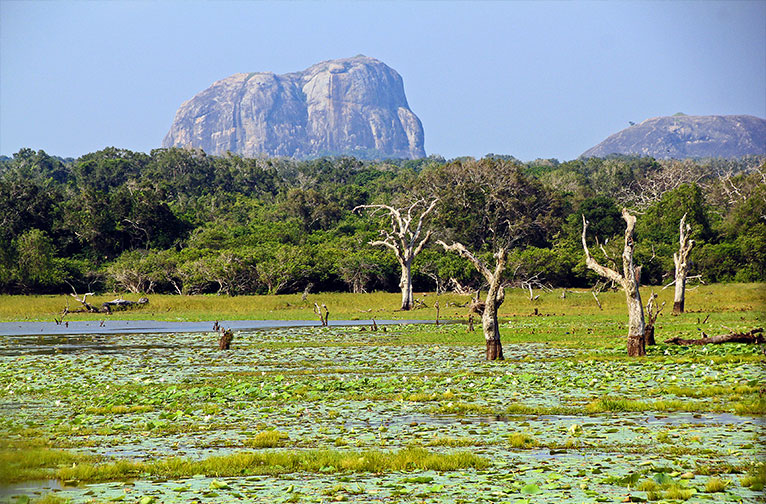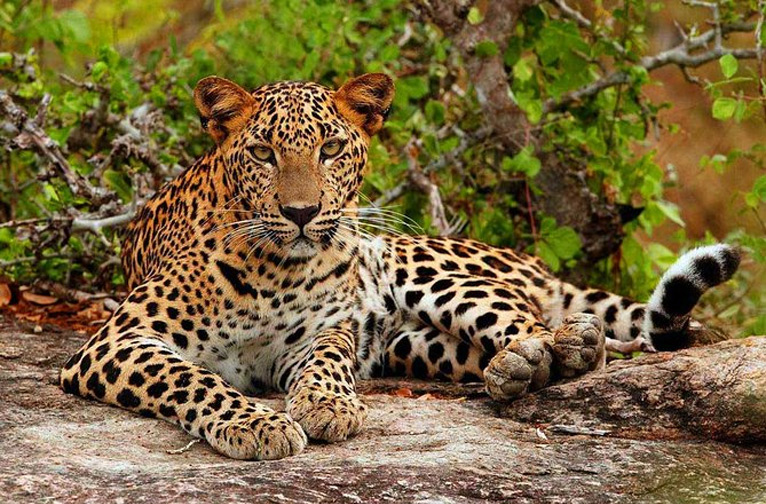Time travel through today’s riches of Sri Lanka’s glory days from antiquity
Anuradhapura
Sri Lanka’s largest archaeological site is Anuradhapura, which attracts streams of tourists. You should train your sights on the less disturbed sites for an off-the-beaten-path experience. Why not explore Ashokarama in the extreme northern bit of Anuradhapura? Located in the little village of Pankuliya it is famous for what is known as the Pankuliya Buddha statue. The 2-meter-high Buddha is seated in virasana pose and features, pretty unique for Sri Lanka, the Abhaya (free from fear) mudra. The Pabbata Vihara monastic site has four sacred spots in the courtyard–the stupa, a bodhighara, a patimaghara and a prasada; these follow a specific architectural style. The site is surrounded by many ruins in various stages of decay. In nearby Mihintale you can visit Veheragala, famed for the painted cave temple and a stupa set upon on a rock. This site is significant for the recovery of the biggest haul of Mahayana Buddhist figurines.
Sigiriya
Set upon 200-m high stony elevation, the palace was built as a fortified retreat for King Kasyapa who ran away here after murdering his father, King Dhatusena of Anuradhapura. It took his brother Mogallana 20 years to avenge that patricide. The resultant capture of Sirigaya meant that Mogallena inherited, by default, all the material and cultural treasures of Kasyapa. When you gaze upon the unparalleled splendour of those fabulous frescoes, you might even summon up visions of Mogallena gloating over his victory with renewed delight.
Amongst other treasures he garnered was Asia’s oldest surviving gardens paced out like the traditional Persian Char Bagh (four gardens) centred around the still-working pools. Mystery still surrounds the means by which they got the water up to the cisterns that used always to be filled up in Sirigaya’s glory days.
Polonnaruwa
The second of Sri Lanka’s kingdom dates to the 12th century. The eight significant archaeological sites here, with their complement of temples, rotundas, tombs, stupas and statuary, provide a vivid picture of Polonnaruwa’s importance in the annals of Sri Lanka’s past. Only three of the original seven tiers of King Parakramabahu’s Palace survived the march of time. It is conjectured that a fire may have caused the place to be abandoned. Another significant ruin is the Thuparama Gedige Temple, from where much of the Buddha statuary was most likely spirited away by antiquity robbers. Look for the carved moonstone doormats found at entrances of some structures. The most hallowed spot in the archaeological park is the is Gal Vihara with its four massive Buddha statues carved into the granite bluff. Hogging the spotlight is the 14m-long reclining Buddha.
Delft Fort
We are all familiar with Galle, the old Portuguese bastion, but few are even aware of another Portuguese ruin in Sri Lanka. Amongst the lesser-known antique treasures, the Portuguese fortress popularly known as the Delft Fort. When it was in the hands of the Portuguese, the island was known as Ilha das Vacas. When it was taken over by the Dutch, it was given the name Delft Island. A 40km boat ride in the Palk Strait, off the mainland of Jaffna, brings you to Delft Island, which also goes by the Tamil name Neduntheeve. Created with a mix of coral and limestone, the fort remains include two pillars of what must have been a strongly fortified two-storied structure.
Of interest here is also the nest of the homing pigeons which used to carry messages between the islands during the Dutch period. The 4m high dovecot made of limestone is in the gardens of the Old Dutch Hospital.
Another worthy site for your attention is the Dalulana Gala (Growing Stone). Locals hold it in veneration, as this limestone rock appears to keep growing. The mystery of this phenomenon holds many in thrall. Geologists have it that its growing in size could result from the upward pressure caused by the growth and expansion of a layer of rock mass beneath it. It could grow by two or three millimetres a year. That said, people are still filled with wonderment at Sri Lanka’s strange growing stone.
From gorgeous corals, to tumblers of Palmyra palm toddies… from feral horses, abandoned by the Dutch when they quit the island, to the giant Baobab tree in the massive hollow of which two adults can shelter, Delft Island’s wild beauty is truly worth exploring on a day trip.
Yala National Park from the Ruhuna Kingdom


A treasure trove of rare delights is Yala National Park, a gift from the erstwhile Ruhuna Kingdom. Dating back to 205 (BCE) when India’s Chola ruler King Elara conquered Anuradhapura the Rahuna Kingdom marks an important era in Sri Lanka’s history. King Dutugamunu of the Southern Kingdom of Ruhuna repelled the Cholas and established himself as a warrior king to be reckoned with. Today, visitors marvel at Yala’s abundant wildlife, including leopards, elephants, water buffalo, and astonishing avifaunal wealth. The Buthuwa Wewa and Athuru Mithuru Wewa, built to support the agricultural areas, reflect the legacy of the irrigation system set in place back in the day here. Unmissable are the notable charms of the ancient ruins of the Akasa Chaitya around which have been located significant caves, dagobas, stone fences and inscriptions from the Yala region a UNESCO-acclaimed World Heritage Site. Noteworthy too are Yala are the fantastic cave paintings.
Sri Lanka’s Legendary Gemstones
From as far back as the time Marco Polo’s visit to the island, Sri Lanka has been famous for its colored gemstones. The most famous amongst them is the “Ceylon Sapphire”, recognised as the premium-colored stone of the world. Even mentions from Sri Lanka’s ancient chronicle, the “Mahavansa”, underpin its reputation for its “Wealth in Gems”. Amongst its fantastic variety of gemstones are treasures such as blue sapphires, star rubies, aquamarines, topazes, amethysts, garnet, alexandrites, corundum, chrysoberyl, spinel, beryl and tourmaline. Passing into legend have been wondrous pieces such as the glorious Blue Giant of the Orient (466 cts), Logan Blue Sapphire (423 cts), Rosser Reeves Star Ruby (138.7 cts), Great Aqua of Sri Lanka (946 cts), Blue Belle of Asia (400 cts) and Star of Sri Lanka (393 cts). It shouldn’t surprise you a bit that centuries back Sri Lanka was called Ratna Deepa (Island of Gems) because of its great wealth of natural gems.
Memories of Sri Lanka’s incredible hidden gems serve as a wonderful catalyst for deeper explorations of this gorgeous island state. Repeat visits should definitely be in your travel plans for many years to come.